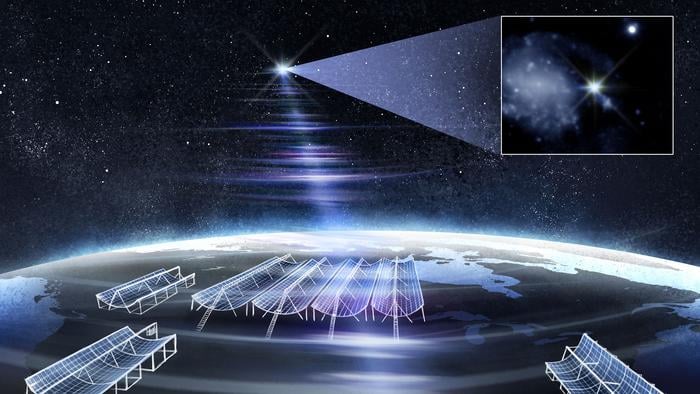Researchers Achieve Precision in Locating Non-Repeating FRB

Fast radio bursts (FRBs) are among the most intense signals in the universe. Emitting the equivalent energy of our Sun over several days in mere milliseconds, these phenomena have puzzled scientists for years. Recent advancements from the Canadian Hydrogen Intensity Mapping Experiment (CHIME) have led to a breakthrough in pinpointing the origins of non-repeating FRBs. This discovery, detailed in a paper published in The Astrophysical Journal Letters, marks a significant step toward understanding these powerful cosmic events.
The CHIME telescope, operational since 2018, recently enhanced its capabilities with the completion of the “Outrigger” extension. This addition comprises smaller telescopes located approximately 66 kilometers from the main array in British Columbia, West Virginia, and California. By forming a very long baseline interferometer (VLBI), the system can analyze signal differences across the four locations. This technology allows researchers to localize the sources of FRBs with unprecedented accuracy.
In March 2023, CHIME recorded a remarkable event: FRB20250316A, nicknamed “radio-brightest flash of all time” (RBFLOAT). This particular FRB is notable not only for its brightness but also for its relatively close origin, located in the nearby galaxy NGC 4141, about 130 million light years from Earth. The new VLBI features enabled researchers to narrow down the burst to an area just outside a star-forming region on one of the galaxy’s spiral arms, achieving an impressive accuracy of 42 light years.
This level of precision is remarkable, especially considering the fleeting nature of an FRB that lasts only for a few milliseconds. With the enhanced data, researchers utilized additional observational resources, including the Katzman Automatic Imaging Telescope (KAIT) and Coddenham Observatory, to investigate the region both before and after the burst. No optical signals were detected prior to RBFLOAT, and subsequent observations from the Keck, Gemini, and MMT observatories found no additional signals, despite over 200 hours of monitoring by CHIME.
RBFLOAT, categorized as a non-repeating FRB, raises intriguing questions about its origin. While magnetars are a commonly suggested cause, the evidence points away from this theory. The signal originated from an area devoid of active star formation, suggesting the magnetar could have been ejected from its region or possibly formed elsewhere. The exact cause of this FRB remains uncertain, indicating that further research is necessary.
This discovery exemplifies how CHIME’s new Outrigger extensions can help researchers locate and analyze one-time FRBs. As detections increase, patterns may emerge, leading to a deeper understanding of the mechanisms behind these powerful cosmic signals. The findings could ultimately shed light on one of astronomy’s most significant mysteries: the origins of the universe’s most potent signals.
As the investigation into FRBs continues, scientists remain hopeful that these advancements will help unlock the secrets of the cosmos. The collaboration between various observatories and the innovative technology of CHIME may pave the way for future breakthroughs in understanding the universe’s phenomena.






